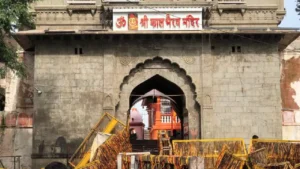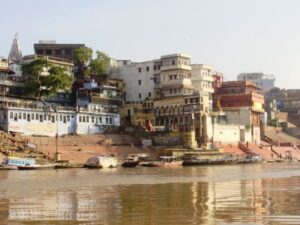One of the dwadash (12) Jyotirlings, Shri Kashi Vishwanath Mandir, is the main temple in Varanasi as well as one of the most prominent Hindu temples in India. The name ”Vishwanath” means ruler of the universe; the literal meaning of “Vishwa” is a universe, and Nath means excellent.
Lord Shiva is worshipped in the form of a linga in this temple. You can carry offerings like water, milk, flowers, leaves, fruits, or sweets inside the temple, but due to security reasons, only a small proportion is allowed inside.
People of Varanasi believe that before taking blessings from Lord Shiva in the Kashi Vishwanath Temple, one must visit Kashi Kotwaal and Kaal Bhairava Temple.
Let’s discover the best historical temples of Varanasi
People of Varanasi believe that before taking blessings from Lord Shiva in the Kashi Vishwanath Temple, one must visit Kashi Kotwaal and Kaal Bhairava Temple.
1. The Kal Bhairava Temple
Located in the ancient city of Varanasi, it is of great historical and cultural importance. Devotees worship Bhairava, a fierce form of Lord Shiva, who is depicted with a garland of skulls and a peacock feather weapon.

The term “Kal” signifies both “death” and “time,” and Kal Bhairava is revered as the protector from these fears. It is a common practice for pilgrims to offer sesame oil and flowers to the deity, although it is not mandatory.
2. The Sankat Mochan Hanuman Temple

This temple is dedicated to Lord Hanuman, the epitome of Lord Shiva, known for his dedication, bravery, and strength. Known as “Sankat Mochan,” which means “remover of troubles,” the idol of Hanuman is decorated with Kesari Sindoor and faces the idol of Rama, whom Hanuman worships wholeheartedly.
A distinctive aspect of this temple is the presence of shops selling ladoo as prasad within the temple premises. Monkeys can be seen frolicking on the roofs and grounds of the temple, yet they do not disturb the devotees’ offerings.
Tuesdays and Saturdays are the busiest days at the temple. The annual Sankat Mochan Sangeet Samaroh, held in April, features performances of classical music and dance by talented artists from across the nation.
During Hanuman Jayanti, a procession called Shobha Yatra commences from the Durga temple (Durga Kund) and concludes at the Sankat Mochan Temple. Devotees can enhance their spiritual experience by visiting the temple during these festive occasions.
3. Sarangnath Temple, Sarnath
A renowned location situated in close proximity to the historic city of Varanasi is home to the legendary Sarangnath temple. According to mythological beliefs, Lord Shiva resides here with Goddess Parvati throughout the entire month of Sawan.

Visitors who come to this sacred place to pay their respects to the Lord are said to receive blessings from Lord Shiva, Devi Parvati, and Lord Sarangnath, who is Shiva’s brother-in-law. The temple has a sacred pond known as Shivkund, where devotees take a purifying dip before climbing 44 steps to perform the Jalabhishek of Sarangnath Mahadev.
There is a popular belief that individuals suffering from severe skin issues may find relief by visiting the Sarangnath Mahadev temple. Moreover, couples struggling with infertility may be blessed with children if they visit and pray at the temple with unwavering faith.
During the auspicious month of Savaan, this historical temples of Varanasi experience a significant surge in visitors.
4. Tripura Bhairavi Temple
Situated in the heart of Varanasi, the historical temples of Varanasi include the sacred Tripura Bhairavi Temple, dedicated to Goddess Bhairavi. This temple enchants devotees with its unique allure and spiritual ambiance. According to a prominent legend, the origins of this temple are deeply rooted in ancient Hindu scriptures, making it a revered site for worshippers seeking divine blessings.

It is believed that Goddess Bhairavi arose from the flames of Lord Shiva’s anger during his Tandava dance, symbolizing destruction. She took the form of Bhairavi to defeat the demon Tripurasura, resulting in the name Tripura Bhairavi.
People believe that praying to the goddess protects them from negative forces and brings prosperity and success. The temple has numerous tales of miracles, with devotees sharing their prayers being answered and their recoveries from illnesses or life-changing events, reinforcing their faith in the divine power of Goddess Bhairavi.
5. Markanday Mahadev Temple
The Markandey Mahadev Temple, located in the peaceful village of Kaithi, is one of the historical temples of Varanasi and a hidden treasure of spiritual importance. This ancient temple, dedicated to Lord Shiva, is steeped in history and reverence. Named after the esteemed sage Markandey, a devout follower of Lord Shiva, it is believed that the temple was established many centuries ago, making it a significant site for devotees seeking spiritual solace

The folk tale says that Sage Markandey was blessed with the divine grace of Mahadev, attained immortality, and had a vision of the Lord himself. This sacred encounter led to the formation of the temple in Kaithi, where the divine presence of Mahadev continues to bless and guide worshippers today.
The Maha Shivaratri festival is the main event that attracts a large number of devotees.
6. Mrityunjay Mahadev Temple
The temple is dedicated to Mahadev (Lord Shiva). Mrityunjay Mahadev means “the god who triumphs over death.” The history of this temple lies behind the Shivling and an ancient well.

Also, it is considered that the Shivlings in this temple keep away all the devotees from their unnatural deaths.
Lord Shiva is worshiped as Mrityunjay Mahadev by devotees in order to triumph over his unnatural death. People from all over India come here and perform “Mrityunjay Path” to get rid of their problems.
On the campus of the temple, there is an ancient well (also known as a koop). The water in this well has therapeutic effects on human beings. It is considered a mixture of several underground water streams and has miraculous effects for curing numerous diseases.
Another story behind this historical temple of Varanasi the magical well is that a famous person, “Dhanvantari” (the father of Ayurveda), poured all his medicine into it. That’s why the water in this well is sacred and has medicinal effects as well as being able to cure various diseases.
7. Jungambadi Math
The holy city of Varanasi has this unique and oldest math, which belongs to the people who come from Karnataka and Maharashtra and follow the Veer Shaiva philosophy. The people from this sect worship only the Shivalings, and while entering the premises of the math through colorful doorways, you’ll see thousands of small and miniature Shivalings.

There are a number of rows and rooms full of shivalings neatly placed. You can see the large shiva-lings surrounded by smaller ones as well.
The reason why there are so many shivalings is that in this sect, a shiva linga is kept here in remembrance of those who die an untimely or unexpected death. To traditional Hinduism, it is the equivalent of Pind Daan.
Sadhus and students who study the Vedas stay there. The biggest festivals that attract devotees are Mahashivratri and Diwali.
Varanasi, often referred to as the “City of Temples,” is home to approximately 1000 sacred sites, underscoring its reputation as a revered religious capital. Among these, the Shri Kashi Vishwanath Temple, one of the twelve Jyotirlingas, stands out as a beacon of spiritual significance. However, numerous other historical temples of Varanasi also hold a powerful and unique aura.
Each temple in Varanasi has its own rich history and spiritual significance, contributing to the city’s deep religious heritage. If you are planning to visit Varanasi, make sure to include these holy temples on your spiritual journey to fully experience the divine essence of this ancient city.

